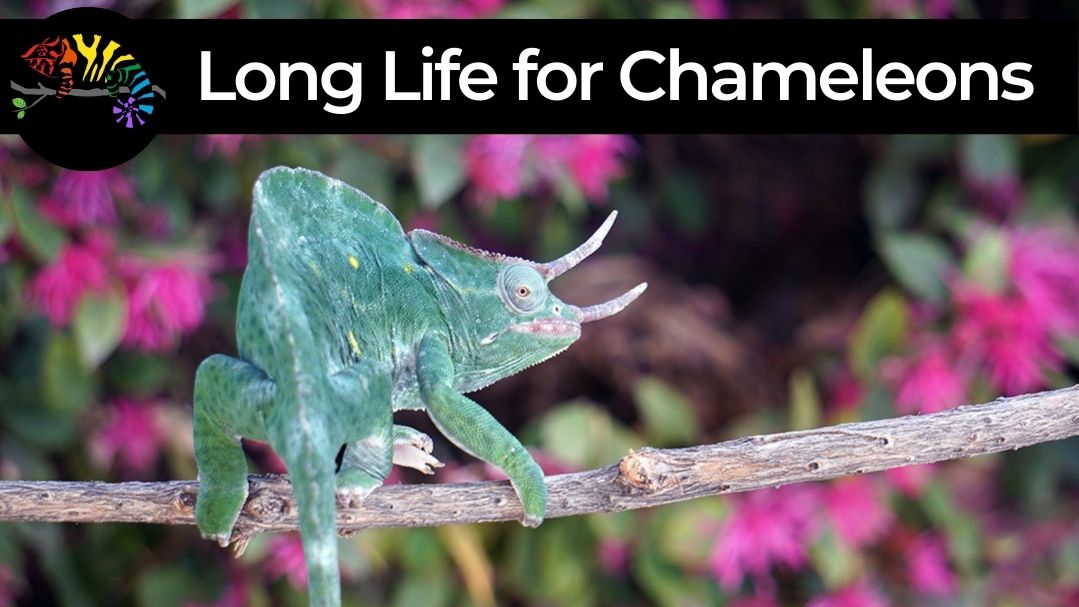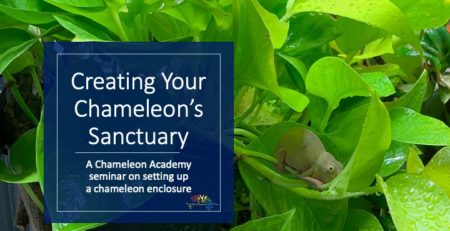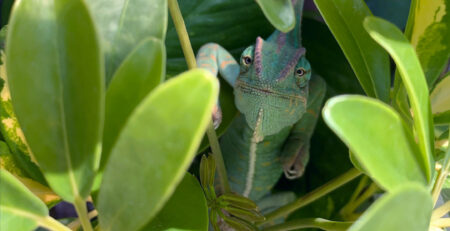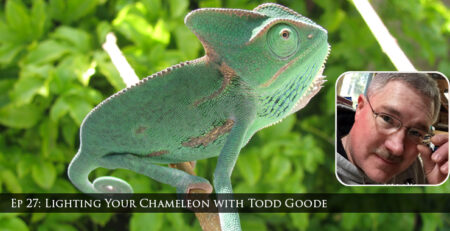How to give your chameleon a long life
Chameleons are valued members of our households and we want them to live as long of a life as possible. Now, we may say a long life which we measure in years, but the assumption behind that is years filled with a high quality of life. Luckily, with the current state of what we know this is possible. Today I explore the top things you can do to give your chameleon many years filled with a quality of life
You can read the page or listen along with an audio podcast episode embedded right here.

How Long Do Chameleons Live?
Chameleons will live between three and 20 years depending on the species. There are over 200 species of chameleons from the smallest stump-tailed chameleon which can perch on your fingertip to the huge Parson’s Chameleon that would perch on your forearm. The most common species of chameleons, the Veiled Chameleon, Panther Chameleon, and Jackson’s Chameleon have commonly had a life span of five years, but recent husbandry changes are pushing that to seven years. And we expect to be able to make 10 years of life a common place. Chameleon Keepers have already proven that it is possible to keep them alive for more than ten years. We are just working on figuring out the ideal husbandry so everyone can enjoy the same results!
Here is the latest in what we believe will increase the life of your chameleon.
How to give your chameleon a long life
Although chameleons can be a challenge to keep, the information is available for how to do it right. But it often isn’t as simple as grabbing the care brochure from the rack a the big box pet store. Unfortunately, there is a lot of bad information on the care of chameleons. The reason is not that people want to give bad information, but that we are learning so much every year that the best husbandry practices change. I have worked for over four decades on researching chameleon husbandry and collaborating with keepers, breeders, vets, and scientists from around the world to push our husbandry forward. And it is ongoing! This website is the collection of all the information I have gathered and tested. So I recommend going through the Chameleon Academy Basics course that is available for free on this website. It will get you started in the right direction. That said, here are the top three ways to give your chameleon a long life!
-
-
- Give your chameleon a low stress life
- Learn the latest in chameleon husbandry
- Give your chameleon nutritious food
-
Give your chameleon a Low Stress Life
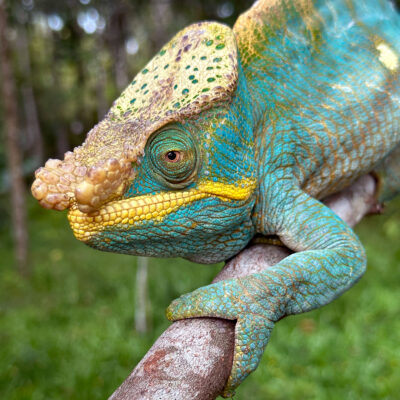
This is an adult male Yellow-lipped Parson’s Chameleon (Calumma parsonii parsonii) in Madagascar.
It may seem obvious that a chameleon needs a low stress life to be healthy. All of us need low stress lives to be healthy! The trick is to know what is stressful to the chameleon. They live completely different lives than we do and we need to look at the world through our chameleon’s eyes.
Chameleons need a sense of security. Chameleons like to have dense plant cover to have the option to hide behind. If you looked at the common cages of the past you would see that there was little cover in the cage and the chameleon was permanently on display. Yes, we like that for ourselves because we want to see our chameleon! But, for a creature that lives its live hiding from predators this is a highly stressful situation for it. Chameleons will learn to recognize you and know you do not mean harm. They will probably get comfortable with you and not use their thick foliage hiding spot, but always knowing it exists is security for them.
Chameleons like to be up high. People are amazed at the difference cage placement can make! A chameleon cage on the floor will have a stressed chameleon as it tries to hide from the humans and pets that walk by. But a chameleon in a cage on top of a dresser where they can perch above head height will be surprisingly calm when those same humans and pets walk into the room.
Chameleons must be kept alone. One of the biggest mistakes keepers make is to give into their desire to give their chameleon a friend. Chameleons do not have the same social structure as we do. We are community creatures – they are solitary creatures. Yes, they interact with each other in the wild, but trapping two in the same cage would stress both of them out. Your chameleon will live a long healthy life without the company of another chameleon. More than that your chameleon’s life will be made shorter if you do force him to live with another chameleon.
Chameleons do not like to be held. For the most part, chameleons will be stressed if they are required to be on your hand or played with. Yes I know there are people on social media talking about how friendly their chameleon is. These are usually owners who are projecting their desires onto a stressed and scared chameleon that feels trapped and has given up trying to escape. There are a small number of chameleons that seem to not care about humans and these are popular to show on social media. The problem is that these are few and far between and to expect that in your chameleon sets you up for disappointment. And the saddest thing for a chameleon is to be neglected because the owner expected their chameleon to play with them. Do not be one of those owners. If you get a chameleon then accept your chameleon for what they are and don’t try and force them to be different. A great way t interact and build up your relationship is to train them to eat from your hands. That interaction is not only not stressful, but it is relationship building!
If you would like to learn more about helping a chameleon feel secure, this multimedia webpage goes in deeper detail. Sense of Security for Chameleons
Learn the latest in Chameleon Husbandry
The best thing you can do for your chameleon to live a long life is stay informed as to the latest in Chameleon Husbandry. Our chameleon knowledge is growing every year! On one hand that is exciting that we are learning so much about how to better keep chameleons! On the other hand, it can be overwhelming to try and keep up. But, over the past ten years we have developed a better awareness about proper cage type, UVB requirements, and chameleon hydration methods. And all these things add years to your chameleon’s life. The best way to keep on the cutting edge is to listen to the Chameleon Academy Podcast. I produce that podcast specifically to bring together the latest things that people are doing in the community. All that information is represented on this website so you are in the right place for the latest advances in chameleon care!
If you are just starting out then it is easy to adopt the newest methods. But if we are talking about pushing your chameleon’s life to ten years and beyond you have plenty of time to get comfortable in the husbandry method that you started with and resist anything different. Avoid getting stuck in one method. Case in point, I got my first chameleon over 40 years ago. When I started the Chameleon Academy Podcast 8 years ago I was on the cutting edge of chameleon husbandry. My husbandry now is very different because of all that I learned and, literally, worked with community members to figure out. It is very easy to get stuck with what you feel comfortable with. But we are not yet in a position were we can sit back and grow comfortable with what we know!
If you would like to start your research into the latest in chameleon husbandry the best place to start is the free course here on the website Chameleon Basics.
Give your chameleon Nutritious Food!
It is obvious that every living being needs the right food. But with chameleons that means a little research and going out of many people’s comfort zone. Chameleons eat live insects and so, not only do you need to keep the chameleon food alive, you must feed it nutritious food so they can be nutritious for your chameleon! This means you will have to learn to take care of the bugs! Even if you are getting ten crickets at a time from the pet store you will need to gutload them with fresh vegetables, fruits, and grains for about 24 hours before feeding them to your chameleon. Otherwise you might be feeding an empty shell of a cricket which will provide minimal nutritional benefit.
Chameleon nutrition is a combination of gutloading the feeder insects and adding an appropriate supplementation routine. You can read in more detail here Chameleon Nutrition
Chameleon longevity is our mission

A Calumma crypticum chameleon sleeping in the Ranomafana National Park in Madagascar. Seeing chameleons in their natural condition is a necessary step to creating as natural of a captive environment as possible.
The whole purpose for continuing to study chameleons in the wild is to unlock the secrets to their ideal care. Chameleons have a tolerance range like any other animal. And they will do what it takes to survive. But just growing and mating is not an indication that the husbandry is ideal. It just means that the husbandry is within acceptable tolerances. Longevity is the key metric to gauge our husbandry. The first challenge in figuring out what it takes to extend a chameleons life is that direct proof of what we are changing or implementing is, by necessity, ten years away! And, so, if we are going to work towards longer life we need to select a standard to what we will work towards. It is common sense that we use what they are used to in the wild as our gauge as to what husbandry methods we should explore.
The second challenge is that we are far enough into learning about chameleon husbandry that we are now working through micro stresses. We know that it is life stress that shortens life. This is the same for every living creature. Eating ice cream or smoking a cigarette is not going to do much to our lifespan as it is a micro stress on our body to process a sudden burst of sugar or deal with smoke inhalation. But do that every day or multiple times a day and the effects start to add up. The harder we make our body work to keep functioning the sooner we wear out the parts. This is a truth whether we are talking about our house, our car, us, or chameleons. We have already figured out some of the big stresses that we can remove from our chameleon’s life. Cohabitation, being kept too hot, poor nutrition, being handled, being placed next to a pet parrot, seeing a ceiling fan overhead,…the list goes on and on for the big stressors that we have identified. But now we are working on identifying the micro stresses. These are small stresses that will add up over time. The problem is that it is hard to prove that they are stress points because they add up over the months. Examples include no nighttime drop in temperature, and swings between dehydration and hydration each day. It is impossible, with our current situation, to put numbers to any test. So, how can we determine if we are going in the right direction?
The only answer that makes sense is that we strive to create a captive environment that mimics the natural environment as close as is possible. If we cannot measure the small stresses in our individual chameleons we can, at least, judge the value of our husbandry against how closely it replicates the natural condition. To be sure, we need to apply our best judgement as to what of nature is beneficial and necessary and what is simply tolerated or even deadly. Nature holds the key to determining the ideal husbandry, but it also is a relentless killer of anything living. So, yes, the puzzle is far from easy to discern! But that is what we chameleon herpetoculturists do with our lives. And there is no doubt that there are decades of research still ahead of us!
If you are interested in learning how to keep your chameleon living long and healthy according to our current knowledge, I recommend going to the Species Profiles in the menu to find a detailed care guide for the species you are keeping. If you have not yet decided on a species and are doing basic chameleon research then the perfect place to start is this page here Chameleon Basics.
Thank you for joining me here on the Chameleon Academy. This is a record of my journey to learn as much as possible about chameleons and how we can keep them healthy. I got my first chameleon over 40 years ago and have loved them ever since. Studying them has taken me around the world and has allowed me to interview keepers from around the world. I am glad that this website is able to share my life’s work with the next generation of chameleon keepers. I can’t wait to see where the next generation of chameleon keepers takes us!

